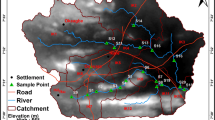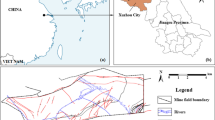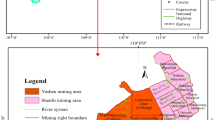Abstract
The closure of many coal mines has resulted in many being used as massive underground mine water storage systems in urban areas. We used a comprehensive fuzzy method to assess the suitability of abandoned coal mines as underground reservoirs. Five first-level and four second-level indices were chosen based on the hydrogeological conditions. The degree of membership of each index was determined and quantitatively graded into suitability grades of I–V using a trapezoidal fuzzy number membership function. The weight of each index was determined in accordance with information entropy. Abandoned mines in Xuzhou city were examined as a case study. The degree of suitability of the water in 14 abandoned mines was assessed. Six of the abandoned mines earned a suitability grade of I and II and should be given priority. The evaluation of abandoned mines as underground reservoirs provides a new means to potentially secure an emergency water supply in urban settings.
Zusammenfassung
Die Schließung vieler Kohlebergwerke führte dazu, dass viele als unterirdische Wasserspeicher in städtischen Gebieten genutzt wurden. Mittels Fuzzy-Methode wurde die Eignung von stillgelegten Kohlebergwerken als Untergrundspeicher bewertet. Basierend auf den hydrogeologischen Bedingungen wurden fünf Indizes der ersten und vier Indizes der zweiten Ebene ausgewählt. Der Grad der Zugehörigkeit jedes Index wurde unter Verwendung einer trapezoiden Fuzzy-Zahl-Zugehörigkeitsfunktion bestimmt und quantitativ in Eignungsgrade von I bis V eingeteilt. Die Wichtung jedes Index wurde unter Berücksichtigung des Informationsgehaltes bestimmt. Die stillgelegten Bergwerke in der Stadt Xuzhou wurden in einer Fallstudie untersucht. Der Eignungsgrad des Wassers in 14 stillgelegten Bergwerken wurde bewertet. Sechs der stillgelegten Bergwerke wurden mit einem Eignungsgrad von I und II bewertet und sollten bevorzugt werden. Die Bewertung von stillgelegten Bergwerken als Untergrundspeicher liefert ein neues Mittel zur Sicherung der Notwasserversorgung städtischer Gebiete.
Resumen
El cierre de muchas minas de carbón ha dado lugar a que muchas se utilicen como sistemas masivos de almacenamiento subterráneo de agua en las zonas urbanas. Utilizamos un método difuso exhaustivo para evaluar la idoneidad de las minas de carbón abandonadas como depósitos subterráneos. Se eligieron cinco índices de primer nivel y cuatro de segundo nivel en función de las condiciones hidrogeológicas. El grado de membresía de cada índice se determinó y calificó cuantitativamente en grados de idoneidad de I a V utilizando una función de membresía difusa trapezoidal. El peso de cada índice se determinó de acuerdo con información entrópica. Las minas abandonadas en la ciudad de Xuzhou se examinaron como un caso de estudio. Se evaluó el grado de idoneidad del agua en 14 minas abandonadas. Seis de las minas abandonadas obtuvieron una calificación de idoneidad de I y II y se les debe dar prioridad. La evaluación de minas abandonadas como depósitos subterráneos proporciona un nuevo medio para proteger potencialmente un suministro de agua de emergencia en entornos urbanos.
抽象
众多已闭坑煤矿在城市周边形成了大规模地下水存储系统。利用模糊综合分析法评价了废弃矿井构建地下水库的适宜性。基于地质条件分析,选取了5个一级和4个二级评价因子。利用梯形模糊隶属度函数,确定了各指标的隶属度,定量地将其分为I~V适应度等级;依据信息熵确定了各指标的权重。以徐州为例,分析了14座废弃煤矿作为地下水库的适宜性。六座废弃煤矿被评为I和II级适宜度,应优先考虑开发利用。废弃煤矿构建城市地下水库为城市应急供水提供了新途径。






Similar content being viewed by others
References
Barnev P, Stanchev P (1987) Fuzzy sets. Narodna Prosveta, Jusautor (in Russian)
Cairney T (1973) Utilisation of disused coal mines as water storage reservoirs. J Hydrol 19(3):251–258
Cheng WM, Qi YD, Yu YB, Pan G (2013) Integrated utilization of low-grade thermal energy in hot coal mine. J Coal Sci Eng (China) 19(1):26–32
Diamond P, Kloeden P (1994) metric spaces of fuzzy sets: theory and applications. World Scientific, Singapore
Dubois D (1980) Fuzzy sets and systems: theory and applications. Academic Press, New York City, pp 370–374
Feng Q, Li T, Qian B, Zhou L, Gao B, Yuan T (2014) Erratum to: chemical characteristics and utilization of coal mine drainage in China. Mine Water Environ 33(3):287–288
Gandy CJ, Younger PL (2007) Predicting groundwater rebound in the South Yorkshire coalfield, UK. Mine Water Environ 26(2):70–78
Gu D (2014) Water resources protection and utilization technology for coal mining in western China. In: Proc, 31st Annual International Pittsburgh Coal Conf: Coal (in Chinese)
Gu D (2015) Theoretical framework and technical system of underground reservoirs in abandoned coal mines. J Chin Coal Soc 40(2):239–246 (in Chinese)
Hayashi JI, Denma D, Takahashi H, Kumagai H, Chiba T (2000) Experimental examination of existing slurry models for coal softening and resolidification. Fuel 79(3):391–397
Icaga Y (2007) Fuzzy evaluation of water quality classification. Ecol Indic 7(3):710–718
Kranz K, Dillenardt J (2010) Mine water utilization for geothermal purposes in Freiberg, Germany: determination of hydrogeological and thermophysical rock parameters. Mine Water Environ 29(1):68–76
Li P, Qian H, Howard KW, Wu J, Lyu X (2014) Anthropogenic pollution and variability of manganese in alluvial sediments of the Yellow River, Ningxia, northwest China. Environ Monit Assess 186(3):1385–1398
Liu M, Wei J, Wang G, Wang F (2017) Water resources stress assessment and risk early warning—a case of Hebei Province China. Ecol Indic 73:358–368
Ma LQ, Zhang DS, Xiang LI, Fan GW, Zhao YF (2009) Technology of groundwater reservoir construction in goafs of shallow coalfields. Int J Min Sci Tech 19(6):730–735
Onderdonk NW (2007) Vertical-axis rotation controlled by upper crustal stress based on force balance analysis: a case study of the Western Transverse ranges of California. Tectonophysics 436(1–4):1–8
Ordóñez A, Jardón S, Álvarez R, Andrés C, Pendás F (2012) Hydrogeological definition and applicability of abandoned coal mines as water reservoirs. J Environ Monitor 14(8):2127–2136
Singh V, Hegazy M, Fontanelli L (2009) Assessment of reservoir uncertainties for development evaluation and risk analysis. Leading Edge 28(3):272–282
Tonder GJV, Usher BH, Dennis I, Vermeulen PD (2007) Predicting rebound in a deep colliery in South Africa. Mine Water Environ 26(2):79–87
Wang Q, Yang Z (2016) Industrial water pollution, water environment treatment, and health risks in China. Environ Pollut 218:358–365
Weber WJ (1972) Physico-chemical processes for water quality control. Wiley-Interscience, New York, pp 261–277
Wu C, Maurer C, Wang Y, Xue S, Davis DL (1999) Water pollution and human health in China. Environ Health Persp 107(4):251–256
Wu Q, Zhou W, Li D, Di Z, Miao Y (2006) Management of karst water resources in mining area: dewatering in mines and demand for water supply in the Dongshan mine of Taiyuan, Shanxi Province, north China. Environ Geol 50(8):1107–1117
Wu Q, Fan S, Zhou W, Liu S (2013) Application of the analytic hierarchy process to assessment of water inrush: a case study for the no. 17 coal seam in the Sanhejian coal mine, China. Mine Water Environ 32(3):229–238
Yang B, Sui W, Duan L (2017) Risk assessment of water inrush in an underground coal mine based on GIS and fuzzy set theory. Mine Water Environ 36(4):617–627
Zadeh LA (1965) Fuzzy sets. Inform Control 8(3):338–353
Acknowledgements
The authors acknowledge the financial supported by NSFC (U1710253), the Project Funded by the Urban Geological Survey of Xuzhou, and the Key Research and Development Plan (Guide) project of Shanxi (201603D321003).
Author information
Authors and Affiliations
Corresponding author
Rights and permissions
About this article
Cite this article
Liu, Q., Sun, Y., Xu, Z. et al. Assessment of Abandoned Coal Mines as Urban Reservoirs. Mine Water Environ 38, 215–225 (2019). https://doi.org/10.1007/s10230-019-00588-3
Received:
Accepted:
Published:
Issue Date:
DOI: https://doi.org/10.1007/s10230-019-00588-3




